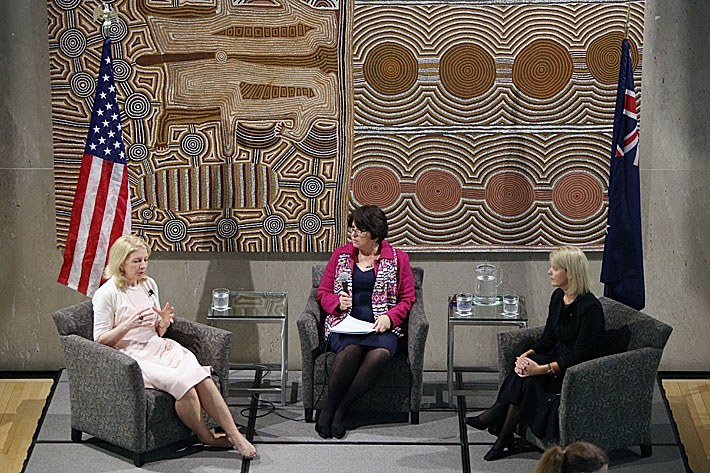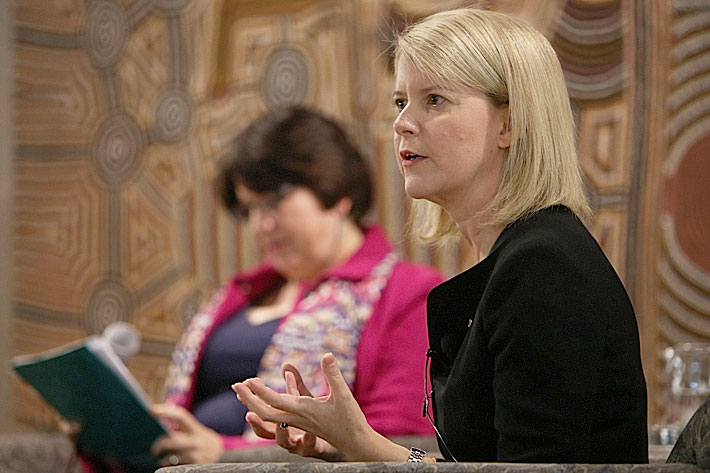When Natasha Stott Despoja goes through airport security, she often hears a familiar question: “What’s this about an ambassador for women and girls? Have you got one for men and boys?”
Ms. Despoja said that despite gains women have made in education, health and government in the past two decades, gender equality remains a far cry from reality in countries throughout the world, including her own.
“I’m constantly amazed by the number of individuals, in our region in particular, who are astounded by some of the slow progress in Australia,” said Ms. Despoja, the Australian ambassador for women and girls. “It’s a humility but also a realism to acknowledge that we’re all in this together.”
At the Embassy of Australia Tuesday, Ms. Despoja joined U.S. Ambassador-at-Large for Global Women’s Issues Catherine Russell and Global Women’s Institute Director Mary Ellsberg to reflect on how governments have advanced the lives of women in the past two decades—and why it still isn’t enough.
This year marks the 20th anniversary of the 1995 World Conference on Women, a landmark event that brought together nearly 30,000 participants. After the conference, representatives from 189 governments produced the Beijing Declaration and Platform for Action, the most progressive blueprint ever for advancing women’s rights. The platform outlines strategic objectives in 12 critical areas, such as violence against women and the human rights of women.
Tuesday’s discussion, co-hosted by the George Washington University and the Australian Embassy, coincided with the 59th Session of the Commission on the Status of Women, which took place earlier this month and focused on the Beijing Platform.
“There was an understanding that we have a long way to go,” Ms. Despoja said, referencing the meeting hosted at the United Nations headquarters in New York.
The United States was the first government to appoint an ambassador for global women’s issues in 2009, followed by Australia in 2011. Sweden became the third country to create this role in 2015.
“I want to see other comparable countries, appointing similar positions,” Ms. Despoja said.
Ms. Russell said it is her role to grow community awareness about how developing the status of women in individual countries can benefit the world.
“If you recognize women’s valuable contribution and their different perspectives, you will see your economies be more robust and your country will be more sustainable,” Ms. Russell said. “While we all hopefully believe that women and girls are entitled to full rights and opportunities, my job is really to say that it is in the strategic interest of the United States for other countries to recognize this as well.”
At the Commission on the Status of Women, the U.N. released sobering statistics about violence against women and girls, revealing that about 35 percent of women worldwide had experienced physical violence in their lifetime.
While numbers like these are alarming, Dr. Ellsberg pointed out that having statistics about women and violence at all is a big improvement from what was available in 1995.
“I do think that 20 years later, the fact that we can say with a lot of precision how much violence there is per country and that we know at least a legal framework is being created to address it, is something to celebrate,” she said. “At the very least, we can’t say that we didn’t know. We have no excuses now.”
 U.S. Ambassador-at-Large for Global Women’s Issues Catherine Russell, Global Women’s Institute Director Mary Ellsberg and Australian Ambassador for Women and Girls Natasha Stott Despoja discussed how governments have advanced the lives of women in the past two decades. (Rob Stewart/GW Today)
U.S. Ambassador-at-Large for Global Women’s Issues Catherine Russell, Global Women’s Institute Director Mary Ellsberg and Australian Ambassador for Women and Girls Natasha Stott Despoja discussed how governments have advanced the lives of women in the past two decades. (Rob Stewart/GW Today)


